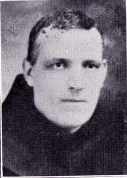
NEGenWeb Project
Church/Catholic
Franciscans
Chapter XVI
St. Michael's Church, Tarnov, Platte County
Tarnov is situated in Burrows township. The first settlers were John and Joseph Burrows after whom the township was named. They came at the end of the sixties. Other old settlers were Richard Bahel, George Lamb, James Noonan, A. M. Buckley, Christian Greisen and others. In August, 1873, the polling place was located at the Greisen home (now John Greisen's place). The first school was opened in 1873 or 1874. The school board was composed of: Jacob Gutler, moderator; Samuel Galley, treasurer; G. W. Galley, director.
THE FIRST POLISH SETTLERS ARRIVE
Soon a number of Polish immigrants began to settle in Burrows township, mostly near the present Tarnov. The first to arrive, so it is said, were Mr. and Mrs. Thomas Wichlacz, who must have come about 1873 and settled on a place about half a mile north of Tarnov. Other early settlers were probably Andrew Grzechowlak, Franz Kowak, Charles Barnas, Simon and Mary Jaworski and their son John. John Jaworski purchased from Mr. Zinnecker three eighties and paid $725 for them. The first land he bought had a sodhouse, a barn filled with straw, a wagon and two plows. He took another eighty acre tract as a homestead and a one hundred and sixty acre timber claim. Later on he acquired more land, paying five, ten, and finally sixty dollars an acre.
Valenty Wichlacz, brother to Thomas, arrived in 1877, and lived about one mile north and one and one-half mile west of the present village of Tarnov. He later moved to Wisconsin. Thomas and John Torczon probably immigrated together, the former residing about four miles southwest and John one and one-half miles east of the church. John Ciochon and Frank Paprocki were probably the next to arrive, in 1877 or 1878. John Ciochon lived on the present John Barnas farm, about one-half mile northwest of the Catholic church. Frank Paprocki belongs to the charter members of St. Michael's parish. He gave six acres for the church and his widow, Sophia, added two acres more. Frank passed to his reward in July, 1894. In 1878 Joseph and Sophia Paprocki arrived and settled one and one-half miles southwest of the present town. About a year and a half later Bartholomew and Mary Barnas (October 7, 1879) settled here. On all Saints day they moved into a sod house purchased of John Ciochon. About 1882 they made their own brick and built a home at the time President J. Garfield was assassinated. John Sliva came to America July 15, 1877. For two years he worked as a farm hand near Columbus, then bought forty acres of land west of Oconee, where he resided two years. He moved to Clearwater, in Holt County. But finding no church near by, he returned to Tarnov after three months and resided several years in a sodhouse, located eight miles southwest of the church.
John Prorok settled west of Platte Center. John Kush came in 1881 and settled nearly two

Bro. Massaeus Korus
miles south of Pilzno, which is about seven miles south of Duncan, where for three years he worked on the railroad. In 1884, he bought eighty acres at fifteen dollars an acre, three and a half miles south of Tarnov. He married Agnes Barnas. Some land was to be had at ten dollars an acre, but few Polish pioneers had the money to purchase it. Andrew and Augusta Korus also arrived about 1880 or 1881 and settled two and a half miles west of the Polish settlement. Andrew Grzechowiak came from the east and resided two miles northwest of Tarnov. Next came John and Agnes Placek and Paul Maslonka and his brother Thomas. The latter in time moved to Holt county. About this period also came Walenty, William and Catherine Torczon, kind-hearted benefactors, to whom the parish owes the bell, blessed in June, 1928. Joseph and Magdalene Matya first rented the Mausbach place, one and one-half miles east of Tarnov. Later they moved to the present John Koziol place, one and one-half miles north of Tarnov. Valenty Jarosz, a married man and Mathew Jarosz, still single, settled about four miles northwest of town. Joseph Jazwiec a benedict, made his home about three miles southwest of Platte Center. Ladislaus and Bartholomew Bogus, brothers, also were early settlers in the vicinity
392
![]()
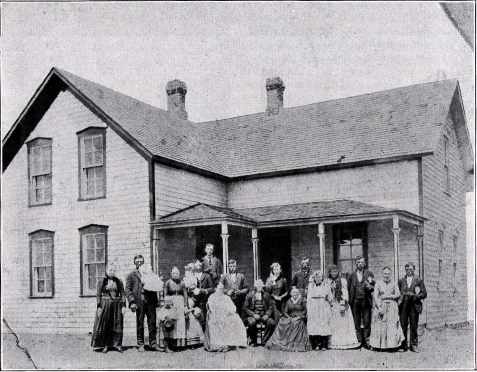
The Barthol, Paprocki and Mary Barnas Families.
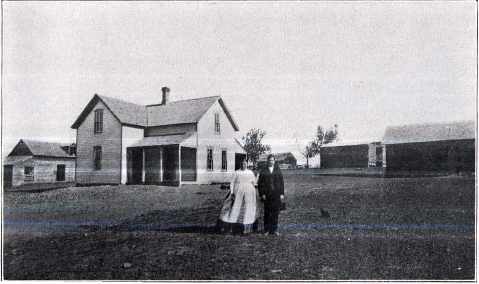
Frank and Sophie Paprocki, Tarnov.
393
![]()
of the present Tarnov. John Sawica established his home northwest and Paul Gawer, one mile north of the settlement. Mr. Augustyn resided three miles west; Adam Worzala settled one mile north, he eventually moved to Holt county. Frank Lutomski and Anton Marron, (a married man) and Frank Hustek (also married) settled about two and one-half miles northwest of the village.
John Czarkowski arrived from Missouri and occupied a farm three miles northwest of Tarnov. Mr. John Kapustka soon removed to Holt County. Paul, John and Henry Torczon, natives of Galacia, Austria, came to Burrows, now Tarnov, in 1879. For five years the two latter lived northwest of town in a sod house, worked their land with ox teams and for some months carried their whole water supply from a neighbor until they could get a well of their own. Many were the trips made on foot to Columbus and back, to do their shopping. Five boys and eight girls were born to their union. Marron lived at the present Anton Jaworski place, two miles northwest of the church. From Duncan came John Liss a carpenter, who later built the present Tarnov church and purchased a farm four miles northwest of the village. Somewhat later came Albert Zaucha and Thomas and John Olszowka from Chicago, Illinois, settling three miles northwest of the church. Stanislaus Mostek came directly from Europe; the brothers Jacob and Joseph Cielocha, both married, and Mathias and Peter Bryg likewise settled near the church, three miles southeast. John Starzec's farm was one mile east, later near Platte Center (on the Mathias Bryg farm). Albert Starzec, living one-half mile east of Tarnov, later moved away. Jacob Syslo, a married man, occupied a farm five miles west of Tarnov, after working two years as a hired hand. The oldest settlers have been here about fifty-four or more years.
THE FOUNDING OF BURROWS (TARNOV)
The founding of a village was finally realized on July 25, 1889, when the Union Pacific Railroad Company sent a representative to confer with Fr. Anastase Czech, O. F. M., who was to act as an agent between the Company and the owners of the property in platting a new town. Mr. Bartholomew Barnas dickered for some time before he finally donated forty acres to the Railroad company. The town was platted by Thomas L. Kimbal, president of the Union Land Company, And thereby the railroad company was induced to erect property in the settlement, and to allow people to locate there. Mr. Barnas kept every second lot, and thus realized considerable profit by the sale of his valuable land.
GETTING A DEPOT AND AN ELEVATOR
The village of Burrows also had a struggle at the start. In the fall of 1887, seventy people presented a petition to the Union Pacific headquarter to erect a depot at Burrows, since there was ample business to warrant it. Two months later the railroad company gave orders to stop the trains opposite the church. A platform was then erected by the railroad company, on which patrons, in all kinds of weather, were obliged to wait and flag trains, which were frequently belated. One morning, about Easter time, the people of Tarnov awoke to find that they had a new depot-built of large corn doors for the sides and two for the roof; on one side of the building was hung a sign "Wanted: An Agent". Soon after this, when several shipments of beer and other good things mysteriously disappeared and the railroad company had to stand the loss, the Union Pacific decided to build a regular depot.
Through the intercession of the pastor, Fr. Anastase, and several other of the residents of Tarnov (Burrows), the railroad company was finally induced, in 1889, to build a side track and grain elevator. This latter was of great importance, because heretofore the farmers in that vicinity had to haul their grain to Platte Center or Humphrey.
THE NAME OF THE TOWN IS CHANGED TO TARNOV
The name of the village up to this time was "Burrows". As the years went by, however, the Poles increased. Many of them hailed from Galicia and they soon decided to rename the town 'Tarnov" after the principal town in that Galicia province. This was done in 1890.
A post office was established at Tarnov July 24, 1891, with A. C. Lis in charge.
The bank of Tarnov was incorporated September 12, 1911, the capital stock being $15,000. George P. Bissell, P. J. Ternus and J. W. Hutchinson were the incorporators.
The petition for incorporation signed by A. Volz and twenty-nine others was presented to the board of supervisors. The petition was granted July 16, 1905. Mr. A. Volz, Rev. Denis Czech, John L. Flakus, A. C. Lis and J. E. McDaniel were appointed trustees for the village to serve until the election and qualification of their successors.
JOHN JAWORSKI, 1841-1929
Jan Jaworski was one of the oldest settlers in the Tarnov neighborhood. He was born at Jorvnje, a short ways from Gniesno, December
394
![]()
5, 1841. He came to America about 1873, working near Parkersburg, West Virginia, on the railroad and in stone quarries for two years. Jan's parents, Simon Jaworski and Maryanna Kornatka Jaworski, came about a year later than their son.
In July, 1877, John married Miss Anna Szawica (Savage), Fr. Sebastian Cebula performing the ceremony at Columbus. Four children were
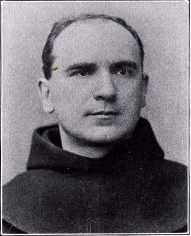
Rev. Anastase Czech, O. F. M.
born to this union: Anthony, Sophia (Mrs. J. Sliwa), Andrew and Mary (Sister Ciotildis, O. S. Fr.). Mrs. Jaworski passed away at the age of 24, whereupon he contracted a second marriage with Miss Juliana Drozd of Tarnov. Fr. Anastase Czech blessed this union, to which were born six children: Joseph, Frank, Victoria, Fr. Stanislaus (now professor at Quincy, Illinois), Monica (Sister Cunegundis, O. S. Fr.), and Maryanna, now a trained nurse. When death again robbed Jan Jaworski of his spouse, he married the widow Mrs. Catherine Plebanek, nee Niemez, who survives her husband.
A GENEROUS BENEFACTOR OF THE CHURCH
Jan Jaworski over a long period of years, gave liberally to the church. It is estimated that he gave from $20,000 to $25,000. He and his family donated the crucifixion group in the cemetery at St. Michael's, costing $1,400 and, shortly before his death, the purgatorial group in the winter chapel, at a cost of about $1,000. For other religious purposes he was always a liberal contributor, exemplifying the fact that wealth does not always make a person stingy towards religion. He was a member of the III Order and of the Men's Society. For a long time he was a daily attendant at Mass and a daily communicant. Despite the fainting spells that visited him in his last years, and the necessity of carrying him out of church occasionally, next day or a few days later, Jan Jaworski would again be at his place in church.
Jan Jaworski passed away May 21, 1929, at the age of 87. His death came unexpectedly while walking to the nearby farm of his son Andrew. When the venerable old man failed to return home in the afternoon, members of the family telephoned to Andrew, who informed them that their father had not been at his place that day. A search was instituted, and his two sons, Joseph and Frank, found the body of their father lying in a field on the road to his son's farm. The attending physician pronounced apoplexy as the cause of his death.
The funeral was held by his son, Fr. Stanislaus Jaworski, assisted by Frs. Sigismund and Casimir. Fr. Denis preached the sermon. Six of his nephews acted as pall bearers. Interment was made near the crucifixion group donated by him.
The Humphrey Democrat said of Jan Jaworski at his death:
"Mr. Jaworski was one of the first settlers in the Polish community in Burrows Township, having homesteaded here about 54 years ago. A man with a high sense of honor, who always dealt fairly with his fellowmen, was ever ready to extend a helping hand to those less fortunate, and never forgetting a friend-he was a
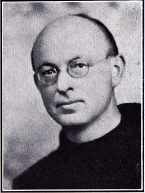
Rev. Stanislaus Jaworski, O. F. M.,
a Son of The Tarnov Parish.
leader in the community throughout the years and was held in high esteem by all who knew him. He was one of the founders of St. Michael's Catholic Church and served for many years as trustee of the church. He took an active part in community affairs and was for many years prominent in the councils of the Democratic Party in the county, but, for holding an office or two in the early days, he never aspired to public dignities. In his more active
395
![]()
years he was frequently a delegate to the democratic county conventions."
TARNOV IN 1930
Tarnov is a small village with a population of ninety-nine, consisting of about twenty-seven houses, one general merchandise store, a hardware store, the Tarnov bank, an implement shop and two elevators: The Farmer's Elevator and The T. B. Hord Elevator. It also has a public school which has at times four pupils or more, sometimes none at all. It has a postoffice in charge of Mr. Alex Wysoski, who also acts as photographer. The pride of the village, however, is the Catholic Church and school and rectory which are the finest group of parochial buildings for miles around.
THE FOUNDING OF ST. MICHAEL'S PARISH 1880
At first, the Germans and Poles in the vicinity of Tarnov attended St. Patrick's, St. Mary's or St. John's at Columbus, and since about 1877, St. Anthony's Church, Burrow's township, which is about two and one-half miles southwest of Tarnov. The first priest there was Fr. Sebastian Cebulla, O. F. M. When, however, difference arose between the two nationalities, the Poles separated and formed their own congregation. This was done under Fr. Cyril Augustinsky.
ERECTION OF THE FIRST CHURCH, 1880
The new church was erected under great difficulties, as the number of Polish families was small and mostly poor. The name of St. Michael's was chosen for the new parish and in December, 1880, Fr. Cyril Augustinsky succeeded in completing a rude church. It was without foundation and plastering and barely shielded the congregation from the weather. It seems, that Mass was said only every two weeks. This being a mission church, the priest had to be gotten eventually from Columbus, or after 1879, from Platte Center, or St. Anthony's respectively. It seems that this was done until 1887, when it was finally agreed that the people would get their pastor from Humphrey, where he was henceforth stationed.
Fr. Cyril Augustinsky was a fine speaker and labored also among the Bohemians at Heun (Maple Creek and Dry Creek), Colfax county, and among the Poles at Columbus and at Duncan. He baptized about twenty-six children at Burrows (Tarnov). The first baptism at St. Anthony's of a Polish child was that of Paulina, daughter of Mr. Hermann and Catherine nee Kowinska. She was born April 3rd, and baptized April 13th, 1878. Sponsors were: John Jaworski and Catherine Hermann. On May 26th, Frances, daughter of Philip and Maryanna Borowna Micek, was baptized. Sponsors were: Thomas Hermann and Sophia Paprocka. On the same day occurred the baptism of Catherine Ripp, daughter of Peter Ripp and Agnes Waringer and of Louis, son of Paul and Anna Lokoma, who was born on May 24, 1878. On June 13, Fr. Sebastian regenerated in the waters of baptism Anthony Jaworski, and Anna Szawica, and on August 25, Michael Ciochon, born August 17, 1878, the son of John Ciochon and Catherine Gembala. The godparents for the later were John Starzco and Tekia Taurocka.
SOME CHARTER PARISHIONERS
(FROM
BAPTISMAL RECORDS)
Besides those mentioned above, the following names occur in the baptismal records of St. Michael's:
1881-John Torczon and Maryanna Augustyn, Jan Jaworski and Anna Szavica, Valenty Wichlacz and Catherine Konwinski, Adalbert Mostek and Catherine Mosgol, Paul Torczon and Maryanna Bogus, Joseph Matya and Magdalene Augustyn, Andrew Grzechoviak and Catherine Szavica, John Placzek and Agnes Lis, John Stack and Maryanna Warzala, Paul Maslonka and Regina Kielbasa, Thomas Maslonka and Kielbasa.
1882-John Knapp and Anna Hoppe, Adalbert Starzec and Maryanna Czochon, John Starzec and Regina Mostek, Andreas Mostek and Maryanna Lis, Ladislaus Bogus and Sophia Brozek, Joseph Paprocki and Sophia Bryg, John Szarkowski and Rosalia Lutomska, Thomas Wichlacz and Catherine Wieczorek, Adalbert Srebro and Maryanna Micek, John Kapusta and Maryanna Koziol, Joseph Sobus and Frances Jaworski, Bartholomew Barnas and Maryanna Lesiak, Anton Bandur and Maryanna Micek, Andrew Szczurek and Catherine Bezok, Adam Warzala and Anna Kuta, Jos. Soulliere and Catherine Hennessey, John Riley and Agnes Kuta, Peter Pluta and Thecla Jazwiec, John Riley and Elizabeth Larkins, John Koziol and Anna Bryg, Martin Placzek and Sophia Olzowska, Martin Malec and Maryanna Mostek, Michael Mathea and Catherine Tomaszewicz, William Duster and Thecla Kawa.
1883-Adam Pejor and Maryanna Bielocha, John Riley and Agnes Jagokota, John Torczon and Maria Augustyn, Thomas Torczon and Thecla Micek, Adam Warzawa and Johanna Kuta, Stanislaus Sliva and Anna Podraza, Andreas Paprocki and Maria Galus, George Grela and Anna Bandur, Thomas Brudny and Johanna Matea, John Sliva and Catherine Galus, William Labenz and Martha Hollacz, Stanis
396
![]()
laus Siedlik and Anna Lasicka, Thomas Jaworski and Josepha Pieczaka, Joseph Kusek and Sophia Augustyn, Michael Mausbach, John Novak and Magdalene, Paul Maslonka and Agatha Kasierot.
A HOME FOR THE PASTOR GOES UP
At the command of the Very Rev. Provincial and the permission of the Rt. Rev. Bishop James O'Connor of Omaha, a residence for the pastor was erected in 1882 or 1883. It was in 1883 that Frank Paprocki donated six acres of land to the congregation for church purposes: This is the site of the present (1901) church, the new school building and other property of the congregation as well as the cemetery.
The parsonage was 12x20 feet and cost $246.40. A sum of $250 had been gathered from the parish for that purpose. Father Anastase Czech, O. F. M., was already serving St. Michael's at this time.
As the church had been erected in a hurry, the building was remodelled and painted in 1884 at a cost of $416.75, whereupon the Rt. Rev. Bishop, James O'connor dedicated the church of St. Michael's on July 2, 1884. Frank and Bartholomew Paprocki, Thomas Wichlacz and Jan Jaworski donated $25 apiece and a bell was purchased in 1886.
A SCHOOL IS BUILT--A. D. 1887
When Fr. Anastase arrived in Tarnov, he found the school situation deplorable. The majority of the people seemed indifferent, if not directly opposed to building a Catholic school. It was many months before the pastor was able to convince them of the need of such a school. Most of them came from Galicia, Austria, where schools had been built and maintained by the state and where they themselves received but little schooling. Attempts were even made to dissuade him from building.
Finally, Fr. Anastase succeeded in gathering enough money to erect a school. Mr. Paul Lakoma undertook to build the entire structure for $400, beginning work on November 1, 1886. The parish then borrowed $300 from Rev. Urban Stanowski, of St. Louis, Missouri, on the condition that the money draw four per cent interest, payable semi-annually and that the principal be paid back within three years. Mr. Wrona was chosen as the first teacher, and school was opened September, 1887.
STIPULATIONS FOR THE SCHOOL
On August 15, 1887, a school meeting was held and four men were elected to confer with the pastor as to what school measures should be adopted. They finally decided that the school children could attend without paying a regular fee, but in the place of tuition, each parishioner should pay a certain sum into the church treasury each year.
An agreement was made with the teacher about wages for the term from September 1, 1887, until March 31, 1888. He received a salary of $80, besides a kitchen stove, free fuel and extra pay for playing the church organ on Sundays, at funerals (Office of the Dead) and other religious services.
Like many other early Franciscan parishes, in lieu of a salary paid the pastor, the priest went about from house to house, from farmer to farmer, each year and. begged for produce and cash, which was to pay his salary for the year. By order of Rev. Praeses Pacific Kohnen, the Tarnov parish was ordered to pay the pastor a yearly salary of $200, thereby doing away with the "Termin", or collection of produce.
SCHOOL TROUBLES
Mr. Wrona did not stay long as teacher. His store of knowledge was limited. His successor, Mr. Paul Nitko did not fare well. As the weeks went by, the pastor, Fr. Anastase was approached with a petition to oust the teacher. He complied with the demand only in so far as to tell the people to retain Nitko until another more competent teacher could be secured.
The disgruntled element was dissatisfied with this promise, as they were reluctant to pay for the upkeep of a Catholic school, when there was already a public school near Tarnov. They, therefore, intimated that if the pastor did not get rid of Mr. Nitko in a very short time, they would oust him. All this time, Mr. Nitko was an innocent victim, as the trouble was due to the hotheadedness of some parishioners.
It so happened that at this critical time, Fr. Anastase was called to Pierce City, Missouri, to conduct a week's mission in Polish. To his dismay and chagrin, upon his return to Tarnov, the pastor found that the rebels had violently ousted the teacher along with his wife and baby. At this turn of affairs, Fr. Anastase conferred at once with Rev. William Choka, the administrator of the Omaha Diocese, and was ordered to close the church of St. Michael's until the offenders begged pardon, and at the same time, Mr. Nitko was directed to have the Polanders implicated in the disgraceful affair, arrested and bound over to the district court. Mr. P. Nitko, who was lodged temporarily in the pastor's house, accordingly swore out a warrant against them, and the seven men were fined five dollars each and costs.
Thinking the matter over more soberly, the seven men, after some weeks, publicly begged pardon of the pastor and Mr. Nitko, and Holy
397
![]()
|
|||